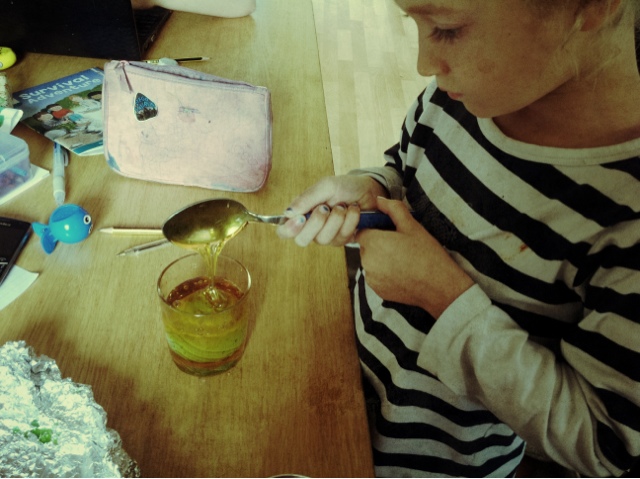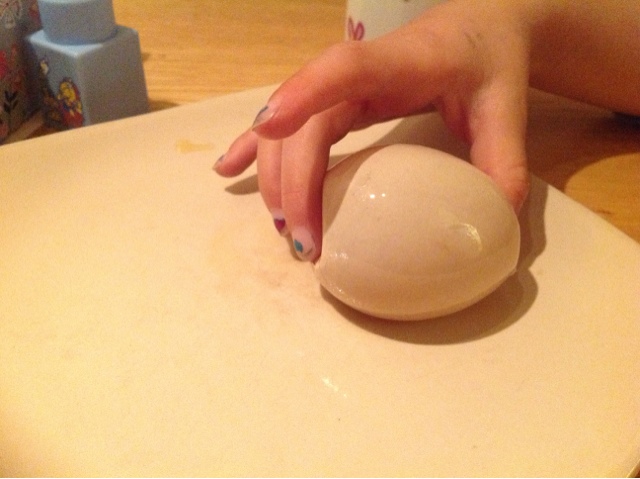This is a really fun experiment but it does take a 6 days at least to complete (that's with no broken eggs) but that's just because it involves leaving it to do it's thing over 24 hours multiple times. The good news is it's cheap to do and safe for little hands and still exciting enough for the older ones (and even the adults).
First of all you need is...
- an egg
- vinegar
- food colouring (red, blue, black or green works best)
- water
- Golden syrup
STEP ONE
Do the bouncy egg experiment but be careful...
When we done this experiment I managed to break one of the eggs that we put in the vinegar. In fact it went splat and exploded all over the work surface and the floor. We still kept it fun and Honi thought it was great to see Mummy making a silly mistake. So did Harmonie in fact.
When we done this experiment I managed to break one of the eggs that we put in the vinegar. In fact it went splat and exploded all over the work surface and the floor. We still kept it fun and Honi thought it was great to see Mummy making a silly mistake. So did Harmonie in fact.
STEP TWO
After waiting 24 hours get your now bouncy eggs out (and don't break it like I did or try bouncing it as it may also break) prepare a glass and have the golden syrup at the ready.
STEP THREE
Put one your bouncy egg in a glass and pour over some golden syrup until the egg is covered with it and leave it for 24 hours.
Put one your bouncy egg in a glass and pour over some golden syrup until the egg is covered with it and leave it for 24 hours.
STEP FOUR
Wait 24 hours - you can hypothesise about what you think is going to happen here. You can even be like a real scientist and write down your what you are doing, your hypothesis and observations you make along the way.
STEP FIVE
When you have studied your egg you will notice it looks a bit like a semi-deflated balloon (if you want to know why this happens keep reading). Now prepare a glass of normal water, from the tap will do, then add to it several drops of food colouring - we chose green simply because it made us laugh to think of green eggs and ham!
Wait 24 hours - you can hypothesise about what you think is going to happen here. You can even be like a real scientist and write down your what you are doing, your hypothesis and observations you make along the way.
STEP FIVE
When you have studied your egg you will notice it looks a bit like a semi-deflated balloon (if you want to know why this happens keep reading). Now prepare a glass of normal water, from the tap will do, then add to it several drops of food colouring - we chose green simply because it made us laugh to think of green eggs and ham!
STEP SIXPut your bouncy egg, that was in your golden syrup and has 'deflated', into your tap water. Leave it for 24 hours and again write up (or talk about) a hypothesis and your observations.
STEP SEVEN
The egg appears to have inflated again! You can talk about or write down your findings and then put the egg that has re-inflated, so to speak, back into some golden syrup like before for another 24 hours to see what will happen again - it will be a little different because of the food colouring but that's all I'm saying.
Finish up with a conclusion in your science journal; write about what you discovered and what you have learnt.
Other things you can try...
You could try using more than egg per experiment and prepare the 2 glasses together - one glass with the plain water (tap water will do) and food colouring and another with the golden syrup, put a bouncy egg in each and leave for 24 hours and then repeat again but switch the eggs. What happens?
You could try different solutions, how much salt in water would you have to add to have the same effect?
Does Honey work as well?
Does Glucose syrup have the same effect?
How does it work?
The egg has a membrane that is semi-permeable (only half waterproof) the liquid inside the egg is a low solute concentration compared to the golden Syrup which is a higher solute concentration.
Because the liquid in the egg is a low solute concentration the liquid inside it passes through the semi-permeable membrane to the golden syrup which is a higher concentrate until the liquid in the egg and the liquid on the outside of the egg is equal in concentration.
You will notice that the golden syrup appears thinner after leaving the bouncy egg in it for 24 hours. This is caused by Osmosis and diffusion.
Basically the liquid solution in the egg has a lower solute, which means it is a thinner liquid so passes through the semi-permeable membrane of the egg to the golden syrup which is a high solute concentrate, a thicker liquid, thinning it down until the concentrate of the golden syrup is equal to the concentrate of the liquid inside the egg.
When we put the 'deflated' egg in the water, the liquid inside the egg is a higher concentrate compared to the water so the water diffuses into the egg re-inflating it. Basically the reverse of the golden syrup experiment.
Diffusion is the movement of substances from areas of high concentration to low concentration.
It is a phenomenon in science and no one knows why it does they just know it does and it's a highly useful process, used a lot in cooking, like when brining or pickling or making a cup of tea amongst many other things.
What's the difference between Diffusion and Osmosis?
Osmosis is the result of diffusion across a semi-permeable membrane.
Diffusion is a spontaneous movement of particles from an area of high concentration to an area of low concentration - like the tea flavouring moving from an area of high to low concentration in hot water in your mug. Doesn’t need water for movement.
Osmosis is the movement of water across a semi-permeable membrane from an area of low solute concentration to a solution with a high solute concentration. Needs water for movement.The egg has a membrane that is semi-permeable (only half waterproof) the liquid inside the egg is a low solute concentration compared to the golden Syrup which is a higher solute concentration.
Because the liquid in the egg is a low solute concentration the liquid inside it passes through the semi-permeable membrane to the golden syrup which is a higher concentrate until the liquid in the egg and the liquid on the outside of the egg is equal in concentration.
You will notice that the golden syrup appears thinner after leaving the bouncy egg in it for 24 hours. This is caused by Osmosis and diffusion.
Basically the liquid solution in the egg has a lower solute, which means it is a thinner liquid so passes through the semi-permeable membrane of the egg to the golden syrup which is a high solute concentrate, a thicker liquid, thinning it down until the concentrate of the golden syrup is equal to the concentrate of the liquid inside the egg.
When we put the 'deflated' egg in the water, the liquid inside the egg is a higher concentrate compared to the water so the water diffuses into the egg re-inflating it. Basically the reverse of the golden syrup experiment.
Diffusion is the movement of substances from areas of high concentration to low concentration.
It is a phenomenon in science and no one knows why it does they just know it does and it's a highly useful process, used a lot in cooking, like when brining or pickling or making a cup of tea amongst many other things.
What's the difference between Diffusion and Osmosis?
Osmosis is the result of diffusion across a semi-permeable membrane.
Diffusion is a spontaneous movement of particles from an area of high concentration to an area of low concentration - like the tea flavouring moving from an area of high to low concentration in hot water in your mug. Doesn’t need water for movement.




Strangely enough, we've been about to start some egg-based experiments here too :)
ReplyDeleteCool! Eggs are great aren't they? there's so much that can be done with them :)
DeleteWe've done the bouncy and green eggs too. And this one with the shells: http://brupesstuff.blogspot.co.uk/2012/02/sitting-on-my-hands-and-cracking-time.html
ReplyDelete:-)